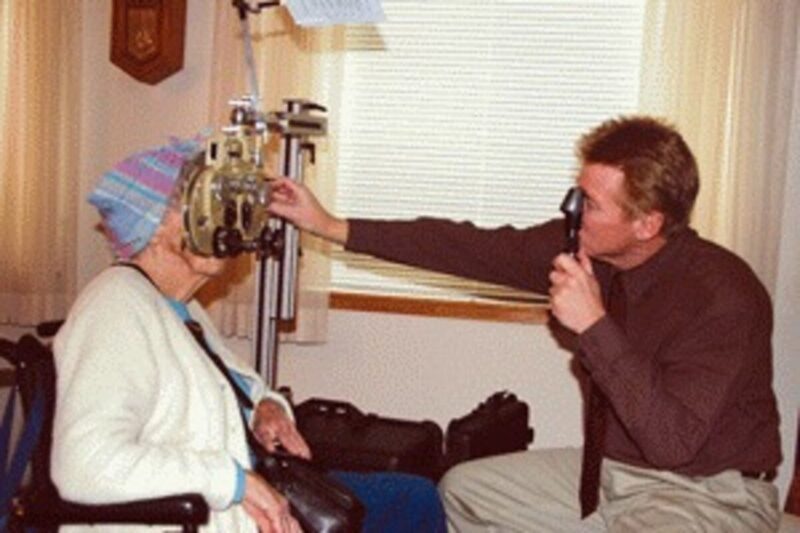Scott Swanson
Of The New Era
Dr. Michael Stoner had a problem.
He has a successful optometry practice in Sweet Home but he wasn’t getting some of the patients he wanted to see.
The ones who couldn’t get to him. So he decided it was time to make house calls, so to speak.
He procured some portable optometric equipment and, in January, started making visits once a month to one of the several retirement homes and care facilities in the area.
“The reason why I got into this is over course of 14 years, I’ve had lot of different facilities bring folks in to have care, and they’ve all expressed in one form or another that ‘it would be really nice for you to come to us,'” Stoner said.
He said patients and residents often are not healthy enough or motivated enough to get to his office on their own and “the time and cost to get those people transported is really a scheduling nightmare.”
His new Mash equipment, manufactured, he said, for mission trips and areas where electricity is not readily available, allows him and his staff optician, Yvonne Weir, to set up an inpromptu examination room in about 20 minutes and requires about the same amount of time to pack up.
The equipment includes a mobile eye examination stand that allows him to forgo the time-consuming and clunky lens frame and box of lenses that he would have to insert into the frame to try to determine which prescription would best work for a patient. Stoner started his new service at Wiley Creek retirement community, where he saw seven people.
He and Weir set up the optometric equipment and gave eye exams to the patients, some of whom arrived in wheelchairs or using walkers.
Stoner said eye problems sometimes get overlooked when people are having physical difficulties, but the ability to see clearly can affect other areas of a person’s health and well-being.
“Studies show that once somebody starts reaching visual acuity of 20/70 or worse – which is about where you need cataract surgery, this mode of depression starts to kick in and their self-esteem goes down, they start to disengage from activities in the home and from other people around them,” he said. “It’s kind of a spiraling cycle.”
Patients, he said, often have “a lot of other issues going on there, and sometimes eyes are not something to worry about.”
Stoner said 5 percent of the population above the age of 65 are in skilled nursing facilities, such as Twin Oaks in Sweet Home. Of those, 25 to 50 percent have some type of visual impairment, such as cataracts, macular degeneration, glaucoma or diabetic retinopathy.
“When somebody has a stroke or becomes frail, and needs that kind of assistance, they still need to do things like watch TV or read or work on a computer,” he said. “Studies have shown that once they get in (a nursing facility), they don’t get proper eye care.”
He said at one facility he recently visited a man was wearing the wrong glasses. He’d had a stroke and family members had provided what they thought were the right pair. Stoner said the glasses the man had were completely wrong, but no one really paid attention to the patient’s complaints.
“Because he’d had a stroke, they thought he didn’t know what he was talking about when he kept telling them ‘I can’t see through these,'” he said. “Making sure people have the right glasses really can make a big difference in their quality of life.”
Stoner said his next planned stop is Heart of the Valley care center in Albany. He said that the portable optometry equipment is key to making his visits work because he can diagnose a patient’s needs much quicker.
“I can figure out quickly, front to back, what I need to do for these folks,” he said. “It’s easier on them because I can do it in 20 or 30 minutes. They get wiped out if they’re there too long.”
He said one bed-ridden patient at Heart of the Valley got an order from her doctor to get her eyes checked.
“They have to have a crane to get her out of bed,” he said. “They were totally psyched when I told them I was coming.”
He said once he gets his routine down, he plans to expand his service to foster homes, which can care for up to five residents.
“I see a lot of those people,” he said. “It’s really hard for them to get to doctors. That whole population is, I don’t want to say neglected on purpose, but just for different reasons they’re not being taken care of in a visual sense. Eye care could make a big difference in their quality of life in rehabilitation homes and cut the costs for different facilities.”
Once he gets his procedure down pat, he plans to share his experiences with other optometrists at conferences.
“They can do the eye care part – we can all do that,” he said. “There’s not really a template to go by (for doing out-of-office care).”
His new service has been hard, “but it’s not routine yet,” Stoner said. “I don’t think I ever sweat in my office, but I sweat in those facilities. I get jacked up, really nervous, because I want to make sure things go all right.”
“I really enjoy helping this sector out because they really need it.”





